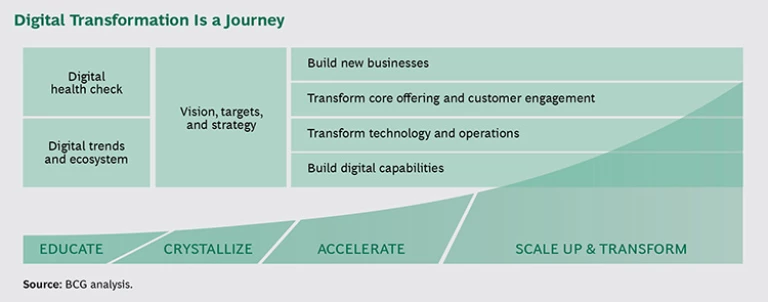Since publication of “The Digital Imperative” (BCG article, March 2015), we have heard from CEOs around the world who are eager to take the next step toward digital transformation. Most executives tell us they understand why their companies need to transform, and most have a basic understanding of what must be done. But a fundamental question remains: how do they make it happen?
The transformation will vary somewhat depending on the company’s current location on the digital journey. (See the exhibit, “Digital Transformation Is a Journey.”) At the outset, companies need to frankly assess their digital maturity and identify gaps relative to competitors. It’s essential to make the right moves in the early days of a digital transformation. To do so, companies need to understand where digital initiatives can have the greatest impact on their business.
After analyzing more than 1,000 companies that were undergoing digital transformation, across multiple industries and geographic locations, we concluded that the most successful companies outperform their competition by excelling in three fundamental areas:
- Speed. How can we move quickly—at digital speed?
- Scale. How can we change the way we work across the entire enterprise?
- Value. How can we create tangible value for the business—and for customers?
To compete in the fast-moving digital world, companies need to execute along these three dimensions, in parallel.
Speed
Large organizations are accustomed to managing large-scale, multiyear projects with fixed timelines and set budgets. It’s not uncommon for an enterprise resource planning (ERP) migration project to take five to ten years from start to finish. But in today’s fast-paced digital economy, such a model is not just outdated—it’s potentially fatal to the organization. To survive, companies need to work and make decisions more rapidly than ever before.
The digital transformation, when done right, is not a monolithic endeavor. Rather, multiple projects run simultaneously on parallel tracks. When selecting initial pilots, teams rally around a business objective (such as increasing conversion rates by a certain percentage) and then brainstorm product offerings that will best achieve that objective. Each team has a captain, or product owner, who drives the process forward and tracks outcomes. (See “Agile Development’s Biggest Failure Point—and How to Fix It,” BCG article, August 2016.) The product owner designs each project to meet an accelerated delivery cycle, allowing teams to rapidly test the project, quickly learn its strengths and weaknesses, and continually adjust course as needed. Each project contributes to a compound effect that benefits the entire enterprise and catalyzes additional pilots. The beauty of this approach is that companies generate results quickly, which helps fund the journey toward ever greater opportunities for innovation. At the same time, the parallel projects gradually build up capabilities for speed within the organization.
A leading North American bank took 18 months, on average, to release new digital products into the market. With startup attackers moving quickly on the digital front, the bank needed to shorten its development period without compromising quality or regulatory compliance. The bank changed three things: the way it organized teams, the way it made decisions, and the way its teams worked. First, the company created cross-functional teams, bringing together people from the business side and the technology side, to follow a product from inception to release. These teams rallied around a business objective, such as increasing incoming applications for mortgages by 10% or increasing conversion rates on credit card applications by 5%.
Unlike in the typical development model, in which IT teams deliver specific functionality (creating a button here or a search box there), the bank’s cross-functional teams had the freedom to design a product as they saw fit—and supervisors evaluated them on their ability to meet their stated business objective. Teams also embraced a new way of working, through agile principles. Rather than engaging in extended philosophical debates on the merits of various offerings, they created prototypes and put these in front of users. By analyzing user feedback, they learned what customers wanted—thus clarifying what they should build. By implementing these new processes, the bank released products in approximately half the time that the process used to take (roughly 8 months instead of 18 months), while maintaining compliance and improving quality.
SCALE
To succeed at scale, companies need to create a culture in which initiatives thrive across varying locations and markets. Any discrete business unit can create an app or launch a pilot—and many do—but scaling up requires a shift in mindset across the entire enterprise. Senior leaders must provide strong, steady support from the top. Cross-functional teams must extend their digital capabilities and ensure that agile principles and the associated culture become embedded across the organization. Meanwhile, internal business units—such as HR, budgeting, and IT—must receive training and development to encourage the right culture and behaviors.
It is also important for teams to think through the end game for each initiative. While brainstorming potential pilots, they need to ask tough questions: Why does this project matter? Can it create significant value? Does it yield a sustainable advantage? Rigorous analysis is an essential part of identifying initiatives that create a true competitive advantage and can scale up rapidly. Digital products can deliver strong ROI when designed thoughtfully (by targeting a key customer segment, for example) and developed with a keen focus on rapid, comprehensive scalability.
Starbucks has become an industry leader in mobile payments, and the company’s journey illustrates the value of scalability. Its digital strategy began in 2008 when the company built an online community and became active on Twitter and Facebook to nurture customer loyalty. In 2009, the company launched its first app, which enabled customers to find Starbucks stores and get nutritional information about its products. This simple app scaled easily and laid the foundation for the company to advance its loyalty program via mobile. Next, Starbucks launched an app to make digital payments possible, using existing technology (rather than developing a new leading-edge technology). Customers could scan a barcode at the point of sale, eliminating the need for money to change hands. Again, the app’s simplicity—from both a technology and a business model perspective—made it seamlessly scalable across store locations. The app also helped Starbucks strengthen its relationship with participants in its loyalty program (who, on average, spend three times as much money on Starbucks items as typical customers do).
The company’s most recent app, which builds on the previous versions, has become a model for the industry. Its Mobile Order & Pay app enables customers to place orders online, pay ahead of time, and pick up their orders without waiting in line. While Starbucks executives may have had this vision in mind from the outset, they started with smaller initiatives that gave them the opportunity to experiment, learn what customers like, build their internal digital capabilities, and improve their offerings. The results have been stunning: app usage continues to grow, revenue is at an all-time high, and today more than 20% of all orders at Starbucks in the US arrive through Mobile Order & Pay.
Value
Above all, a digital transformation must deliver value—not five or ten years down the road, but now. Thus far, digital hasn’t delivered its full potential in many large organizations. In our view, this is because those companies haven’t successfully tackled change management, either from a technology perspective (assessing which initiatives will deliver the most value) or from an organizational perspective (understanding how to manage work differently across the organization). Companies need to address these two aspects of change management in an integrated way—and in parallel.
Once digital projects are underway, project leaders must relentlessly focus on measuring their value in terms of real-world outcomes: customer response, increased revenue, reduced churn, cost savings, time savings, and so forth. Companies must kill initiatives that don’t deliver value. Output is irrelevant—and counterproductive in the long run—if it doesn’t create value. To succeed, organizations must think creatively about how best to capitalize on their assets.
Transport for London (TfL), an organization responsible for all public transit in London, wanted to provide its customers with a mobile app to help navigate public transportation options. Instead of spending public funds to develop its own app, TfL invested in a framework that allowed third-party developers to access TfL’s transportation data and use it to create innovative travel apps, maps, and services on their own. Since the program launched in 2009, more than 8,000 developers have signed up for it. One local startup, Citymapper, used TfL’s data to create an urban navigation app that has become the go-to resource for Londoners—and the company has expanded to cover more than 30 cities. Overall, every £1 invested by TfL in its open data framework has yielded £58 in benefits for Londoners. By embracing open data, TfL created much greater value for its customers, and did so much more quickly than it could have on its own, while also creating extraordinary opportunities for startups like Citymapper.
Although transformation tends to be viewed as an audacious undertaking, the most successful digital transformations start with focused initiatives that deliver on all three dimensions: speed, scale, and value. Once the earliest digital initiatives prove their value, they catalyze the next round of more ambitious follow-on projects. At the same time, a culture shift occurs within the organization, as the company adjusts to digital as a new way of doing business. A well-executed digital transformation doesn’t just even the playing field for large companies—it tips the odds in their favor. With speed, scale, and value on their side, incumbents can fend off attackers and win in the digital economy.






